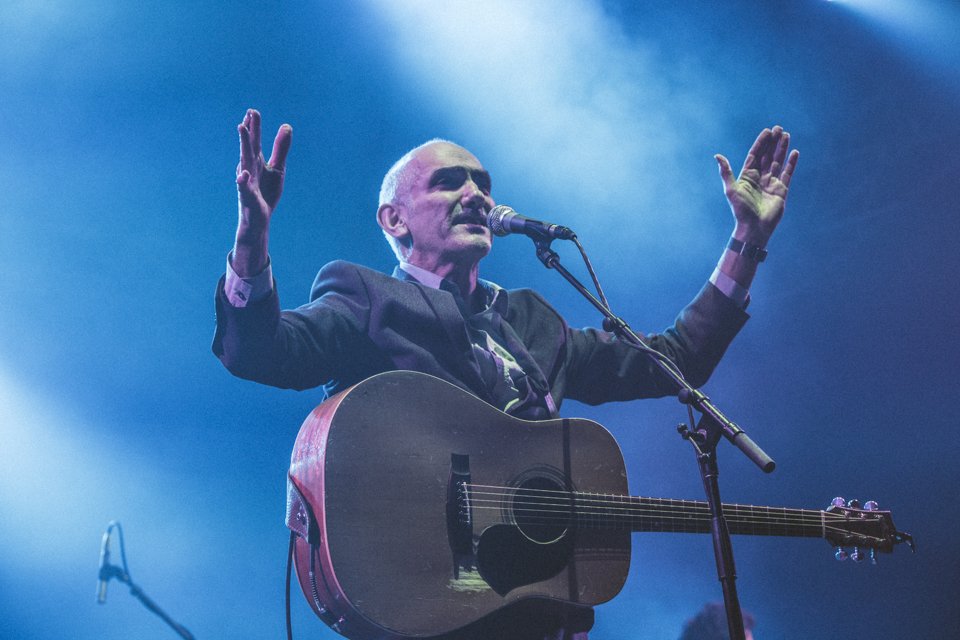Paul Kelly was born in Adelaide in 1955, but musically reared in the bars and share houses of Melbourne and Sydney. He established himself in the early 1980s with the albums Talk and Manila, but the Paul Kelly we love – the musician who’s become a national treasure – didn’t emerge until he was in his 30s.
Kelly’s first public performance was at an open mic night in Hobart when he 19 years old. He played a two-song set consisting of Bob Dylan’s ‘Girl From the North Country’ and the Australian folk song ‘Streets of Forbes’. Kelly’s roamed far and wide in the subsequent 45 years, releasing an astonishing number of records that take in blues, soul, folk, pub rock, new wave, dub, and the aptly-coined adult pop. But if you’re looking for signposts of his artistic identity, then Bob Dylan and traditional Australian folk music are pretty spot-on.
Kelly is often referred to as the Australian equivalent of Dylan, and he’s definitely absorbed a lot of Dylan’s songwriting principles over a lifetime of studious worship. He’s a keen consumer of poetry and seems most comfortable fossicking through the past to retrieve songwriting inspiration. But Kelly is a child of Dylan, which makes the comparison feel non-applicable.
If we’re going to equate Kelly to an icon of American music, then Bruce Springsteen seems more apt. Although they’ve worked at a different pace and the Boss has kept one eye on the arena since early in his career, both Kelly and Springsteen have deep roots in Western folk traditions and a penchant for the blues. They’ve flitted between commercially viable rock music and more introspective, soul-searching territory. Both have an impeccable eye for detail and a way of sketching out characters so that listeners can develop an intimate understanding by a song’s end.
Kelly, like Springsteen, has always surrounded himself with incredibly capable musicians. He’s rarely (if ever) the best muso in the room, but he’s the one with something to say and an unflagging hunger to keep exploring. Kelly’s released 25 studio albums, loads of live records and a handful of EPs across his career. He’s a unique artist for not having an unequivocal purple patch – he hit his stride in his 30s, but sounds as good as ever in his 60s.
Here’s a closer look at the ten best albums from Paul Kelly’s generously consistent back catalogue.
10. Stardust Five (Stardust Five, 2006)
When I spoke to Kelly last year, I tried to uncover what motors his ceaseless creativity. He was typically humble in reply. “I’m a fairly limited musician – I don’t have a great chord knowledge, can’t play lead guitar, don’t write guitar riffs,” he said.
To counter this, he’s always been open to collaboration. Kelly’s various bands – the Dots, Coloured Girls, Messengers, Boon Companions – have been integral to the development of his finest releases. Kelly and the Boon Companions made a bunch of records together the 2000s. This lineup also formed the spinoff group, Stardust Five, whose lone release is a true departure from Kelly’s lyric-driven song-craft.
There’s soundtrack music, surf-rock, Latin-inspired festive songs, and a perspiring collaboration with vocalist Loene Carmen called ‘Pussy Got Your Tongue’.
9. Post (1985)
Post isn’t Paul Kelly’s best album, but it’s one of the most significant. Having split with his first wife and feeling dissatisfied with his first two albums, Kelly left Melbourne for Sydney. He bunked up with Cold Chisel’s Don Walker and got working on a new batch of songs.
The biographical ‘From St. Kilda to Kings Cross’ remains one of his strongest compositions, and it’s bound to induce warm feelings of homesickness in any Australians far from home. It sets the tone for Post, which was Kelly’s first brush with greatness.
The arrangements are spare and unfussy, but it’s not a lo-fi solo release. Sherbet’s Clive Shakespeare ensured much care went into the production. Guitarist Steve Connolly helped defined Kelly’s sound throughout the ensuing decade, and his lead guitar playing adds painterly emphasis to Kelly’s singer-songwriter traditionalism.
8. Paul Kelly presents the Merri Soul Sessions (2014)
Kelly isn’t a bad singer, but he doesn’t have what you’d call a strong voice. He sounds familiar, honest, thin, and isn’t prone to mimicry. So attempting an album of soul music might seem like a fool’s errand, but he knew better than to put himself at the centre of 2014’s The Merri Soul Sessions.
The album is marked by the lead vocals of Vika and Linda Bull, Kira Puru and Clairy Browne, as well as Dan Sultan who also co-wrote a number of its tracks. While it’s steeped in homage, the album largely skirts sentimentality and cliché. The inclusion of Kelly’s regular backing band – featuring drummer Peter Luscombe, guitarists Dan Kelly and Ashley Naylor, bassist Bill McDonald and keyboardist Cameron Bruce – makes it feel all the more authentic.
7. So Much Water So Close to Home (Paul Kelly and the Messengers, 1989)
This was ostensibly Kelly’s first album with The Messengers, but the name had already appeared on overseas releases of 1986’s Gossip and 87’s Under the Sun. Those albums were credited to Paul Kelly and the Coloured Girls at home, a name derived from Lou Reed’s ‘Walk on the Wild Side’. Kelly evidently had no racist intentions, but it’s an eyebrow-raising detail of his biography.
Anyway, So Much Water… was recorded in the US with R.E.M. producer Scott Litt. And while it didn’t yield a major commercial breakthrough in the States, it’s a slickly executed illustration of Kelly’s ability to churn out meaningful songs. 30-plus years later, it feels grossly under-appreciated. For instance, had ‘Careless’ come out of somewhere like Manchester or Liverpool, it’d surely have been canonised alongside songs like The La’s ‘There She Goes’ and James’ ‘Laid’.
6. Life Is Fine (2017)
It took five years before a follow up to 2007’s Stolen Apples arrived. But by the time Spring and Fall came out in 2012, Kelly had also rattled off the A-Z Recordings live album, 2010’s How to Make Gravy memoir, and appeared in Ian Darling’s Paul Kelly: Stories of Me documentary.
Kelly’s trademark prolificacy soon returned, however, and the 2010s became one of the most active and exploratory phases of his career. Life Is Fine is a throwback to the sound of the classic Coloured Girls/Messengers records – tracks like ‘Firewood and Candles’ and ‘Finally Something Good’ bound forward with the sort of gusto that’d put an artist on the map. Kelly’s never taken his listenership for granted, but his writing brims with offhand confidence here.
5. Words and Music (1998)
Words and Music’s title track is a toast to Kelly’s heroes Bob Dylan and The Beatles. But being a Paul Kelly song, the salute is enacted via storytelling, with Kelly providing a tangible image of the power these artists command over him. The song’s bigger picture takeaway is that words and music can offer sustenance, inject wonder into humdrum situations and lead you to cast aside any other responsibilities.
Kelly does all of the above on this 14-track album, which features guitar player Spencer P. Jones and guest vocalists Monique Brumby and Rebecca Barnard. The opening track, ‘Little Kings’, is one Kelly’s most potent protest songs – a thematic area he’s largely avoided. “I’m so afraid for my country,” begins Kelly, singing in a wistful high register. “There’s an ill wind blowing no good / So many lies in the name of history.”
Released in 1998, Words and Music confirmed that Kelly’s ambitions to write great songs hadn’t flagged one bit.
4. Nature (2018)
After the bleeding vitality of Life is Fine, it shouldn’t have been a surprise that Kelly had more left in the tank. But to trump that record just 12 months later with one of his most heartfelt and purposeful releases to date? You gotta be kidding.
Kelly has described Nature as a companion to Life is Fine, but where his previous album recalled the booming muscle of the Messengers’ heyday, Nature is tender, carefully evocative and reverent. The album title is a primer for the subject matter – it’s immersed in the natural world, with Kelly reminding us that humans aren’t the centre, but just an element.
He’s aided by the poems of Dylan Thomas, Sylvia Plath, Walt Whitman, Philip Larkin and Gerard Manley Hopkins. Setting these artists’ words to music is a tall order, but Kelly’s not here to score points. He finds something extra to communicate, and weaves in half a dozen of his own poetic formulations.
3. Ways & Means (2004)
A definitive ranking of Kelly’s various bands is impossible to devise. How can you go past the classic Messengers lineup of Steve Connolly, Michael Barclay (drums), Jon Schofield (bass) and Pedro Bull (drums), who so nimbly illuminated Kelly’s song-craft and accentuated every genre excursion?
But inspiration runs hot across 2004’s Ways & Means and some credit must go to the supporting cast. Nephew Dan Kelly and future Drones member Dan Luscombe are on guitar, with Luscombe’s older brother Pete on drums. The album’s bass player is Bill McDonald, who’s become one of Kelly’s closest late-career confidantes.
You suspect the secret weapon here is Kelly’s personal and creative partnership with his nephew. That and the fact Dan Kelly has a knack for summoning tasteful yet slightly askew, Johnny Marr-inscribed guitar textures.
It’s a double album with the pop and rock tracks on disc one and the sombre folk numbers on disco two. Disc one begins with the cinematic instrumental ‘Gunnamatta’ and Kelly and co.’s momentum never stops rolling from there.
2. Under the Sun (Paul Kelly and the Coloured Girls, 1987)
Under the Sun is the album where Paul Kelly & the Coloured Girls asserted themselves as Australia’s answer to the E Street Band. Like the Boss at the height of his powers, Kelly and co. had no scruples about trialling new sounds and introducing banjo, steel guitar and saxophone into the mix. But when you’ve got songs like ‘Dumb Things’, ‘To Her Door’ and ‘Don’t Stand So Close to the Window’ in your back pocket, it’d be easy to feel unbreakable.
Given its super-charged experimental bent, Under the Sun isn’t Kelly’s most cohesive album, but every song – from the rockabilly ‘Same Old Walk’ to the big screen classic rock of ‘Forty Miles to Saturday Night’ and the Shakespeare-citing ‘Desdemona’ – is a world to get lost in.
1. Gossip (Paul Kelly and the Coloured Girls, 1986)
Gossip came out a couple of years before I was born. By the time I was old enough to have a hunger for music, a good deal of its 22 tracks had become indispensable components of Australian popular culture.
‘Leaps and Bounds’ and ‘Before Too Long’ are some of the great pop-rock songs of the era. The former is an exemplar of saying just as much with what you don’t verbalise. The first chorus consists of just two words: “I remember.” The second includes the tail, “I go leaps and bounds.” But it’s all heartache and yearning, lust for life and feelings of ephemeral bliss.
The whole album is a ride through similarly electric emotions. There are broken-hearted songs (‘Look So Fine, Feel So Low’, ‘Somebody’s Forgetting Somebody’), expressions of empathy for First Nations people (‘Maralinga’) and admissions of failure (‘Stories of Me’). But Kelly’s eyes are on the prize throughout – Gossip is the firmest materialisation of his ambition to be a great songwriter.
–
Paul Kelly with partner with pianist Paul Grabowsky this May at Sydney’s City Recital Hall, performing new arrangements of songs from Kelly’s vast catalogue, and more. See details below.
Paul Kelly and Paul Grabowsky
Tickets on sale now.
Saturday, 30th May 2020
City Recital Hall, Sydney
Tickets: City Recital Hall












